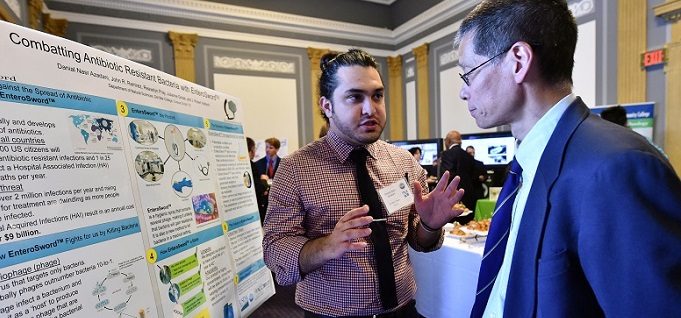Pitching their passion projects
By Tabitha Whissemore
June 21, 2017
Students participating in the Community College Innovation Challenge prove that research opportunities at two-year colleges can change the world.
Danial Nasr Azadani is passionate about his work. That work? Saving lives.
Azadani is part of a team of students from Del Mar College in Texas that developed a spray that slows the spread of antibiotic-resistant bacteria. About 23,000 people in the United States die each year as a result of bacterial infections.
“We can easily prevent this,” Azadani said.
The Del Mar team’s product – EnteroSword – is “ready to destroy,” Azadani said, excitement in his eyes. “EnteroSword is our future.”
Azadani and the team were one of 10 teams of community college students named as finalists for the Community College Innovation Challenge (CCIC), an annual competition sponsored by the American Association of Community Colleges (AACC) and the National Science Foundation. CCIC asks student teams to develop a STEM-based solution to a real-world problem. This year’s categories were Maker to Manufacturer, Energy and Environment, and Security Technologies.
The finalist teams participated in a bootcamp this week in Washington, D.C., and pitched their projects to a group of judges. They also had the opportunity to display their projects – and their knowledge – to some members of Congress at a reception on Capitol Hill. On Thursday evening, Del Mar College was named the first-place winner; Red Rocks Community College in Colorado received second place.
Azadani, who is simulataneously attending Texas A&M University, is thrilled with the opportunity to show off what he’s been able to learn and do at Del Mar.
“The opportunities and resources at Del Mar are mind-blowing,” Azadani said. “We’re doing graduate-level research.”
His teammate John Ramirez is equally as excited with the opportunities he’s had at the community college. He’s previously worked at psychiatric hospital before deciding to go back to school. His first class at Del Mar was a research course and “it’s been a rollercoaster ride from there,” Ramirez said.
“I can’t get enough of research,” he added. Which is probably a good thing, since the team went through a lot of trial and error before coming up with their product. Ramirez, who hopes to attend medical school, said it wasn’t uncommon to get messages about new ideas from his teammates at 2:00 a.m. But that was part of the fun.
Innovations like this will help to grow the nation’s economy, Rep. Brad Schneider (D-IL) remarked at the Capitol Hill reception.
“It starts with science,” Schneider said.
Tiny house, big difference
Azadani and Ramirez weren’t outliers. All the students on finalist teams were just as passionate about their projects.
The team from California’s Laney College is working to overturn homelessness with the Pocket House.
Laney College has made a name for itself building tiny houses. The City of Oakland approached the college about building houses for the homeless population.
The city has the land set aside – they just need the houses.
But there were challenges, explained team member Richard Rothbart. The time, money and resources needed to build so many homes were prohibitive. The students didn’t give up, though – they searched for a solution and found it. Instead of making a traditional tiny house, the team is using advanced manufacturing techniques, such as computer numerical control (CNC) routing and prototyping to fabricate an affordable, mobile shelter that can be mass produced and assembled quickly.
The technique means they can make 100 houses in a year for a tenth of the cost of a regular tiny house.
Rothbart had worked at homeless shelters most of his adult life. He said he’s never seen a city take this sort of pro-active approach to helping the homeless.
“It’s inspiring,” said Rothbart, who has a bachelor’s degree in sociology, but returned to college because he “wanted to use my hands.” With the Pocket House project, he’s able to combine his desire to help others with his passion for creating things.
Read about all the CCIC finalist teams in CC Daily.


